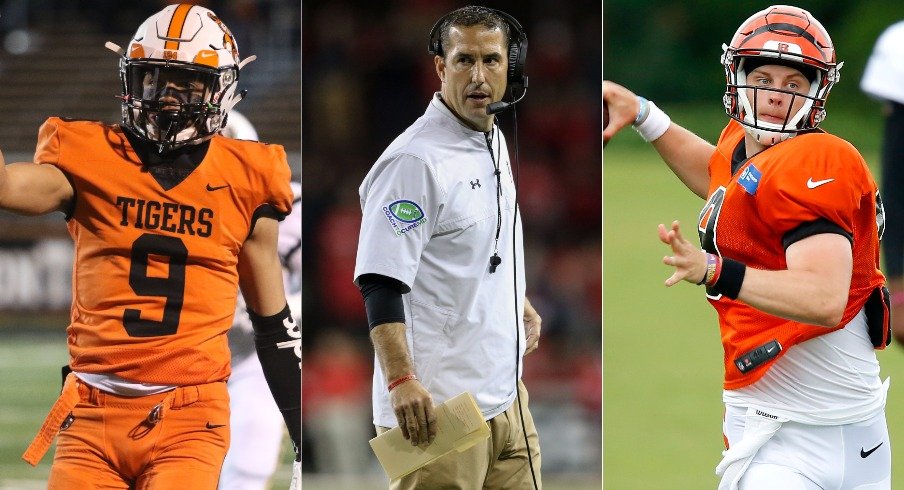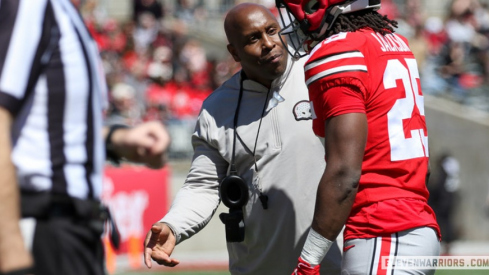Until last week, the news announced Tuesday by Ohio Gov. Mike DeWine would have been cause for celebration for Ohio State football fans: All sports in the state of Ohio – including football and other contact sports – will be allowed to proceed forward this fall.
Now, it’s just another reason for the Buckeyes and their fans to wonder why they’re no longer able to play this fall.
Thanks to Tuesday’s decision by DeWine, the Ohio high school football season will begin as scheduled next week. Middle school and youth teams in the state will be playing games this fall, too. The Cincinnati Bengals, Cleveland Browns and the rest of the NFL remain on track to begin their season in September, and the Cincinnati Bearcats are also set to represent the state in FBS college football this fall, at least as of now.
From high school stadiums on Friday night to NFL stadiums on Sundays, football games will soon be played in the Buckeye State once again. It certainly won’t be a normal football season – DeWine said Tuesday that spectators for high school and youth sports will be limited to family members and “people very close” to game participants, while the high school regular season had already been shortened to six games – but as long as their respective schools believe it’s safe enough for them to play, most football teams around the state will play games this fall.
The same can no longer be said for Ohio State, however, after the Big Ten postponed its fall sports season to spring.
While there are currently football teams within the state of Ohio, at all levels of the sport, who are poised to play this fall, the state’s most popular team – the team that draws more than 100,000 fans to Ohio Stadium for every home game under normal circumstances – is not one of them. While future Ohio State players like Jayden Ballard, Reid Carrico and Gabe Powers and former Ohio State players like Denzel Ward, Vonn Bell and Joe Burrow are set to play in stadiums across the state this fall, current Ohio State players might not get that opportunity at all, or at least not until the spring.
That’s an odd juxtaposition to think about – especially when considering that high school and youth teams will not be required to adhere to the strict COVID-19 testing standards that Ohio State was abiding by – and one that certainly is not lost on those associated with the Ohio State football program.
So you telling me Ohio high schools are safe to play football even though they arent taking no where near the same amount of precautions as we do in the collegiate level and we cant play?????...ok
— Lloyd McFarquhar Jr (@_11savage) August 18, 2020
— Mark Pantoni (@markpantoni) August 18, 2020
Well this makes complete logical sense. https://t.co/ND1k38vfac
— Nicki Meyer Dennis (@Nicki_07) August 18, 2020
If you love football in all of its forms, there’s reason to be happy about Tuesday’s announcement. Unlike the Ohio State seniors and potential NFL draft entrants who are now wondering if they’ll ever play another snap for the Buckeyes, high school seniors will have an opportunity to play one more season before they graduate. You might not be able to actually go to games on Friday nights unless you have a son who plays for a team, but you’ll at least be able to watch some of those games on television.
You might already be a big fan of the Browns or the Bengals or another NFL team, and if you’re not, there’s former Ohio State players on teams all over the league who you can cheer for. If the American Athletic Conference sticks to its guns and plays a football season, Cincinnati would be a logical college football team for Ohio State fans to adopt for the fall, as the Bearcats are coached by former Ohio State player and assistant coach Luke Fickell and are now the only Division I school in the state set to play sports this fall.
But if all of those teams are playing this fall and Ohio State is not, that will be all the more reason for the Buckeyes and their fans to wonder how it can be considered safe enough for all of those teams to play, but not the scarlet and gray.
Given the ongoing COVID-19 pandemic, that’s not to say the Big Ten's determination that it's unsafe to play is necessarily wrong, or that any of those other teams’ seasons are assured to go smoothly. DeWine indicated Tuesday that the state could shut sports back down if there are significant spikes in COVID-19 cases – “if it goes off the rails, don’t doubt that we’ll step in” – so there could certainly be bumps in the road ahead for teams that do play, especially at the high school and lower levels, where it’s certainly fair to question whether sports games should be happening during a pandemic.
Why teams all over the state of Ohio are getting the green light to play this fall while Ohio State is not, though, is what the Buckeyes and everyone who wants to watch them play is wondering right now, especially as the Big Ten has left many questions unanswered since it pulled the plug on fall sports two Tuesdays ago. And every game that another Ohio football team gets to play this fall could be a reminder of the season the Buckeyes have lost.
Luke Fickell photo: The Enquirer/Kareem Elgazzar, Cincinnati Enquirer via Imagn Content Services, LLC
Joe Burrow photo: Joseph Maiorana/USA TODAY Sports


